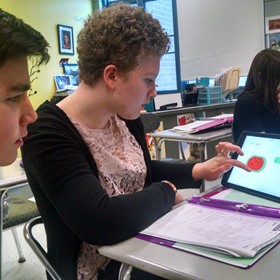Summarized by Saad Khan
 Open source learning has made learning programming for kids a much more fun and interactive experience. Educators can now choose from wide array of options tailored to age groups such as elementary school, middle school, and high school. ScratchJr is an app adapted for beginners. Once the kids get familiar, they can move on to Scratch which enables the students to share their work with other people online.
Open source learning has made learning programming for kids a much more fun and interactive experience. Educators can now choose from wide array of options tailored to age groups such as elementary school, middle school, and high school. ScratchJr is an app adapted for beginners. Once the kids get familiar, they can move on to Scratch which enables the students to share their work with other people online.
Tynker is yet another app that engages the students through interactive lessons where coding is incorporated into geography or social studies lesson plans.
References:
Ford, M. (2017, October 19). Coding Across the Curriculum. Edutopia. Retrieved from https://www.edutopia.org/article/coding-across-curriculum
 Summarized by Mary McCann
Summarized by Mary McCann
Artificial Intelligence is a growing topic, and one of the most recent areas in which it has become discussed in in the classroom. Artificial Intelligence in the classroom can be used to modify learning for individual students. Artificial intelligence works off of algorithms, and can track when students become bored or disinterested, or when they do not follow the lecture. AI programs can then provide tailored instruction to each individual student based on their needs. By collecting data about trends and multiple students performances, AI can also predict how students will do in the future. AI can also judge the effectiveness of teaching curriculum and suggest adjustments and changes. Although current research in Artificial Intelligence in the classroom is mostly restricted to higher education now, it won’t be long before it makes its way into K-12 education.
References:
DICKSON, B. (2017). HOW ARTIFICIAL INTELLGENCE IS SHAPING THE FUTURE OF EDUCATION. PC Magazine, 105.
Summarized by Mary McCann
While some schools are just catching up to the virtual reality train, there’s a new player on the field: augmented reality. Augmented reality is a mixed reality format that uses both real images and situations as well as virtual 3d representations. By using the front camera of a digital device, such as a phone or tablet, and a trigger image, augmented reality programs can display virtual content over real contexts. Augmented reality apps like Quiver ,which scans coloring sheets and turns them into 3d objects, or EON Experience, which uses trigger images to start thousands of simulations, can be used across different content areas as well as grade levels. Other augmented reality apps cater specifically to art, science, and the solar system. As many school districts have already adopted 1:1 mobile device programs, augmented reality is just the next step in digital learning.
References:
Schrock, K. (2017). August 2017: Augmented reality in the classroom.
 By Sangyoon Park
By Sangyoon Park
The author, as a Spanish teacher, shows the type of how students work in their classroom. Students play the role of teacher. This method allows teachers to communicate more closely with students. Here is how students can lead their classes. First, students can create video classes that work in the classroom. Second, it allows students to choose the activities they want. Third, encourage activities through games and quizzes. Finally, students can be given the opportunity to become a teacher of the day. After conducting the lessons in new ways, the teacher always provides feedback through surveys.
References
Poth, R. (2017, July 19). Turn passive learners into leaders by letting students teach!. ISTE. Retrieved from https://www.iste.org/explore/articleDetail?articleid=1026&category=ISTE-Standards-in-Action&article=Turn passive learners into leaders by letting students teach!
Summarized by Mary McCann
 Gartner, a leading business advisory company, has recently released their top 10 trends in influential technology for 2018. These trends include advancements in technology like augmented reality, which is similar to applying virtual reality to the real world, Artificial Intelligence, and cloud technologies. According to Bolkan (2017), “Nearly every app and service will incorporate some level of AI in the next few years” (para. 5). Artificial Intelligence will both be seen and unseen, as companies and app developers create smart programs that adapt to users and learners. Another upcoming trend is digital twins: “virtual representations of real-world objects or systems” (Bolkan, 2017, para. 8). These digital duplicates can be used by business and designers alike to analyze trends and flow of information.
Gartner, a leading business advisory company, has recently released their top 10 trends in influential technology for 2018. These trends include advancements in technology like augmented reality, which is similar to applying virtual reality to the real world, Artificial Intelligence, and cloud technologies. According to Bolkan (2017), “Nearly every app and service will incorporate some level of AI in the next few years” (para. 5). Artificial Intelligence will both be seen and unseen, as companies and app developers create smart programs that adapt to users and learners. Another upcoming trend is digital twins: “virtual representations of real-world objects or systems” (Bolkan, 2017, para. 8). These digital duplicates can be used by business and designers alike to analyze trends and flow of information.
References:
Bolkan, J. (2017). AI, merging of digital and physical worlds among top 10 tech trends for 2018. The Journal. Retrieved from https://thejournal.com/Articles/2017/10/05/AI-Merging-of-Digital-and-Physical-Worlds-Among-Top-10-Tech-Trends-for-2018.aspx?Page=1
Summarized by Sangyoon Park
 The author argues that media literacy education is not being performed correctly. Students are now demanding media criticism. In middle school surveys, 80% of students misunderstand the news. Three out of four students can not distinguish between real news and Facebook. Only one out of three students can respond critically to news sources.
The author argues that media literacy education is not being performed correctly. Students are now demanding media criticism. In middle school surveys, 80% of students misunderstand the news. Three out of four students can not distinguish between real news and Facebook. Only one out of three students can respond critically to news sources.
It can be said that digital literacy education was effective when students understood the difference between real and fake news. ISTE judges students’ digital literacy ability based on the following criteria.
References:
Today’s news: Real or fake?. (2017, November 2). ISTE. Retrieved from https://www.iste.org/explore/articleDetail?articleid=2093&category=Digital-and-media-literacy&article=Today%27s%2Bnews%3A%2BReal%2Bor%2Bfake%3F%2B%5BInfographic%5D
Summarized by Saad Khan
Udacity has made some breakthrough this year by launching its services in China. The company made the initiative of giving out 100 developing courses to Chinese developers at www.youdaxue.com. The nanodegree program caters to online students, and the degree is planned to finish in eight to nine months. This expansion is a significant move for the company mainly after expanding their services in India in 2005.
Another major initiative started by the company is Udacity Connect which is a career-focused meetup service. The online service aims to digitally imitate the practice of group study or professor’s office hours in a way that is convenient online.
References:
Udacity Expands to China and Launches Meetup Service for Students. (2016, July 10). EdSurge News. Retrieved from https://www.edsurge.com/news/2016-04-22-udacity-expands-to-china-and-launches-meetup-service-for-students
Summarized by Mary McCann

In a survey of nearly 3,000 participants in schools worldwide, educational technology company Schoology has found the most common deterrents to using technology in learning. These barriers come from not enough time to implement technology (cited as a reason by 43% of participants), and not enough devices (reported by 40.8%). Although the people surveyed, educators in k-12 schools, recognized the benefits to using technology to enhance education, there were certain barriers, including ineffective professional development and outdated hardware. Interestingly, classes that utilized a library media specialist daily had students who were more engaged in learning. Going forward, we hope studies like these will help persuade school boards and administrators to dedicate more time and money into educational technology.
Schaffhauser, D. (2017, September 18). Biggest barriers to digital learning: Lack of time, lack of devices. The Journal. Retrieved from https://thejournal.com/articles/2017/09/18/biggest-barriers-to-digital-learning.aspx
Summarized by Sangyoon Park

Jennie Magiera, an educator, argues that the transfer of experience through blogging helps her development education skills. She had doubts about sharing her content in blogging at first. She was not sure that writing blogs could affect people and not just waste her time. But her efforts were not in vain.
She is still continually uploading posts to her blog. The blog was not only helpful to other educators but also helped her to receive feedback from her class. She provides some tips for class blogs. The first is to start even if the plan is not accurate. It is also essential to complete rather than pursue perfection. It also suggests that you believe and shares your experience.
References
Randles, J. (2017, October 27). Share your teaching adventure through blogging. ISTE. Retrieved from https://www.iste.org/explore/articleDetail?articleid=1080&category=Education-leadership&article=Share%2Byour%2Bteaching%2Badventure%2Bthrough%2Bblogging
Summarized by Saad Khan

As the technology becomes more and more affordable, its access becomes available to most of the students in the class. Students these days may bring devices like Chromebooks to their classrooms for their study. However, this comes with its own set of problems, distraction factor being at the top of the list.
Holly Korbey talks about her students’ study habit and how they keep distracted because of the technological distractions in the classroom. Some researchers claim that the classwork is not that difficult hence the students get distracted in the class. Although the possibility of no-tech policy is a bit extreme, we can talk with the parents to participate in digital distraction workshops together.
References:
Hertz, M. B. (2014, January 17). Digital Tools and Distraction in School. Edutopia. Retrieved from https://www.edutopia.org/blog/digital-tools-distraction-in-school-mary-beth-hertz
 Open source learning has made learning programming for kids a much more fun and interactive experience. Educators can now choose from wide array of options tailored to age groups such as elementary school, middle school, and high school. ScratchJr is an app adapted for beginners. Once the kids get familiar, they can move on to Scratch which enables the students to share their work with other people online.
Open source learning has made learning programming for kids a much more fun and interactive experience. Educators can now choose from wide array of options tailored to age groups such as elementary school, middle school, and high school. ScratchJr is an app adapted for beginners. Once the kids get familiar, they can move on to Scratch which enables the students to share their work with other people online.






